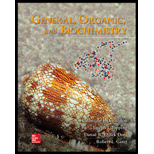
GENERAL ORGANIC+BIOCHEM.-ACCESS>CUSTOM<
10th Edition
ISBN: 9781265799274
Author: Denniston
Publisher: MCG CUSTOM
expand_more
expand_more
format_list_bulleted
Concept explainers
Question
Chapter 22, Problem 22.41QP
Interpretation Introduction
Interpretation:
The number of ions of
Concept Introduction:
The citric acid cycle includes a series of biochemical reactions that use acetyl CoA to form carbon dioxide and play a role in energy production and biosynthesis. It is the last stage of carbohydrates, fats, and amino acids breakdown.
NADH is a coenzyme in all
Expert Solution & Answer
Want to see the full answer?
Check out a sample textbook solution
Students have asked these similar questions
Help fix my arrows please
no Ai walkthroughs
Given the data attached, provide a drawing of the corresponding structure.
Chapter 22 Solutions
GENERAL ORGANIC+BIOCHEM.-ACCESS>CUSTOM<
Ch. 22.1 - Prob. 22.1QCh. 22.1 - How do the mitochondria differ from the other...Ch. 22.1 - Prob. 22.3QCh. 22.1 - Describe the evidence that suggests that...Ch. 22.2 - Prob. 22.5QCh. 22.2 - Prob. 22.6QCh. 22.3 - Prob. 22.7QCh. 22.3 - Prob. 22.8QCh. 22.6 - Prob. 22.9QCh. 22.6 - Write a balanced chemical equation for the...
Ch. 22.6 - Prob. 22.1PPCh. 22.7 - Prob. 22.11QCh. 22.7 - Prob. 22.12QCh. 22.8 - Prob. 22.13QCh. 22.8 - Prob. 22.14QCh. 22.9 - Prob. 22.15QCh. 22.9 - Prob. 22.16QCh. 22 - Prob. 22.17QPCh. 22 - Prob. 22.18QPCh. 22 - Prob. 22.19QPCh. 22 - Prob. 22.20QPCh. 22 - Prob. 22.21QPCh. 22 - Prob. 22.22QPCh. 22 - Prob. 22.23QPCh. 22 - Prob. 22.24QPCh. 22 - Prob. 22.25QPCh. 22 - Prob. 22.26QPCh. 22 - Prob. 22.27QPCh. 22 - Prob. 22.28QPCh. 22 - Prob. 22.29QPCh. 22 - Prob. 22.30QPCh. 22 - Prob. 22.31QPCh. 22 - Prob. 22.32QPCh. 22 - Prob. 22.33QPCh. 22 - Prob. 22.34QPCh. 22 - Prob. 22.35QPCh. 22 - Prob. 22.36QPCh. 22 - Prob. 22.38QPCh. 22 - Prob. 22.41QPCh. 22 - Prob. 22.42QPCh. 22 - Prob. 22.43QPCh. 22 - Prob. 22.44QPCh. 22 - Prob. 22.45QPCh. 22 - Prob. 22.46QPCh. 22 - Prob. 22.47QPCh. 22 - Prob. 22.48QPCh. 22 - Prob. 22.49QPCh. 22 - Prob. 22.50QPCh. 22 - Prob. 22.51QPCh. 22 - Prob. 22.52QPCh. 22 - Prob. 22.53QPCh. 22 - Prob. 22.54QPCh. 22 - To what class of enzymes does dinucleotide...Ch. 22 - Prob. 22.56QPCh. 22 - Prob. 22.57QPCh. 22 - Prob. 22.58QPCh. 22 - Explain why deficiencies of citric acid cycle...Ch. 22 - Prob. 22.60QPCh. 22 - Prob. 22.61QPCh. 22 - Prob. 22.62QPCh. 22 - Prob. 22.63QPCh. 22 - Prob. 22.64QPCh. 22 - Prob. 22.65QPCh. 22 - Prob. 22.66QPCh. 22 - Prob. 22.67QPCh. 22 - Prob. 22.68QPCh. 22 - Prob. 22.69QPCh. 22 - Prob. 22.70QPCh. 22 - Prob. 22.71QPCh. 22 - Prob. 22.72QPCh. 22 - Prob. 22.73QPCh. 22 - Prob. 22.74QPCh. 22 - Prob. 22.75QPCh. 22 - Prob. 22.76QPCh. 22 - Prob. 22.77QPCh. 22 - Prob. 22.78QPCh. 22 - Prob. 22.79QPCh. 22 - Prob. 22.80QPCh. 22 - Prob. 22.81QPCh. 22 - Prob. 22.82QPCh. 22 - Why is the glutamate family of transaminases so...Ch. 22 - Prob. 22.84QPCh. 22 - Prob. 22.85QPCh. 22 - Prob. 22.87QPCh. 22 - Prob. 22.88QPCh. 22 - Prob. 22.89QPCh. 22 - Prob. 22.90QPCh. 22 - Prob. 22.91QPCh. 22 - Prob. 22.92QPCh. 22 - Prob. 22.93QPCh. 22 - Prob. 22.94QPCh. 22 - Prob. 22.95QPCh. 22 - Prob. 22.96QPCh. 22 - Prob. 22.97QPCh. 22 - Prob. 22.98QPCh. 22 - Prob. 22.99QPCh. 22 - Prob. 22.100QPCh. 22 - Prob. 22.101QPCh. 22 - Prob. 22.102QPCh. 22 - Prob. 1MCPCh. 22 - Prob. 2MCPCh. 22 - Prob. 3MCPCh. 22 - Prob. 4MCPCh. 22 - Prob. 5MCPCh. 22 - Prob. 7MCPCh. 22 - Prob. 8MCPCh. 22 - Prob. 10MCPCh. 22 - Prob. 11MCP
Knowledge Booster
Learn more about
Need a deep-dive on the concept behind this application? Look no further. Learn more about this topic, chemistry and related others by exploring similar questions and additional content below.Similar questions
- help 20arrow_forwardProvide the drawing of the unknown structure that corresponds with this data.arrow_forward20.44 The Diels-Alder reaction is not limited to making six-membered rings with only car- bon atoms. Predict the products of the following reactions that produce rings with atoms other than carbon in them. OCCH OCCH H (b) CH C(CH₂)s COOCH མ་ནས་བ (c) N=C H -0.X- (e) H C=N COOCHS + CH2=CHCH₂ →→arrow_forward
- 3) Draw a detailed mechanism and predict the product of the reaction shown? 1) EtMgBr 2) H3O+arrow_forwardHow to draw the mechanism for this reaction?arrow_forward> H₂C=C-CH2-CH3 B. H₂O Pt C. + H2 + H₂O H D. 16. Give the IUPAC name for each of the following: B. Cl Cl c. Cl Cl 17. Draw the line-angle formula for each of the following compounds: 1. phenol 2. 1,3-dichlorobenzene 3. 4-ethyltoluene < Previous Submit Assignment Next ▸arrow_forward
arrow_back_ios
SEE MORE QUESTIONS
arrow_forward_ios
Recommended textbooks for you
 ChemistryChemistryISBN:9781305957404Author:Steven S. Zumdahl, Susan A. Zumdahl, Donald J. DeCostePublisher:Cengage Learning
ChemistryChemistryISBN:9781305957404Author:Steven S. Zumdahl, Susan A. Zumdahl, Donald J. DeCostePublisher:Cengage Learning ChemistryChemistryISBN:9781259911156Author:Raymond Chang Dr., Jason Overby ProfessorPublisher:McGraw-Hill Education
ChemistryChemistryISBN:9781259911156Author:Raymond Chang Dr., Jason Overby ProfessorPublisher:McGraw-Hill Education Principles of Instrumental AnalysisChemistryISBN:9781305577213Author:Douglas A. Skoog, F. James Holler, Stanley R. CrouchPublisher:Cengage Learning
Principles of Instrumental AnalysisChemistryISBN:9781305577213Author:Douglas A. Skoog, F. James Holler, Stanley R. CrouchPublisher:Cengage Learning Organic ChemistryChemistryISBN:9780078021558Author:Janice Gorzynski Smith Dr.Publisher:McGraw-Hill Education
Organic ChemistryChemistryISBN:9780078021558Author:Janice Gorzynski Smith Dr.Publisher:McGraw-Hill Education Chemistry: Principles and ReactionsChemistryISBN:9781305079373Author:William L. Masterton, Cecile N. HurleyPublisher:Cengage Learning
Chemistry: Principles and ReactionsChemistryISBN:9781305079373Author:William L. Masterton, Cecile N. HurleyPublisher:Cengage Learning Elementary Principles of Chemical Processes, Bind...ChemistryISBN:9781118431221Author:Richard M. Felder, Ronald W. Rousseau, Lisa G. BullardPublisher:WILEY
Elementary Principles of Chemical Processes, Bind...ChemistryISBN:9781118431221Author:Richard M. Felder, Ronald W. Rousseau, Lisa G. BullardPublisher:WILEY

Chemistry
Chemistry
ISBN:9781305957404
Author:Steven S. Zumdahl, Susan A. Zumdahl, Donald J. DeCoste
Publisher:Cengage Learning

Chemistry
Chemistry
ISBN:9781259911156
Author:Raymond Chang Dr., Jason Overby Professor
Publisher:McGraw-Hill Education

Principles of Instrumental Analysis
Chemistry
ISBN:9781305577213
Author:Douglas A. Skoog, F. James Holler, Stanley R. Crouch
Publisher:Cengage Learning

Organic Chemistry
Chemistry
ISBN:9780078021558
Author:Janice Gorzynski Smith Dr.
Publisher:McGraw-Hill Education

Chemistry: Principles and Reactions
Chemistry
ISBN:9781305079373
Author:William L. Masterton, Cecile N. Hurley
Publisher:Cengage Learning

Elementary Principles of Chemical Processes, Bind...
Chemistry
ISBN:9781118431221
Author:Richard M. Felder, Ronald W. Rousseau, Lisa G. Bullard
Publisher:WILEY